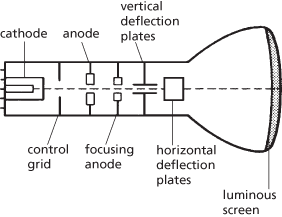The device that provides the viewing screen in a traditional television tube, a radar viewer, or a cathode-ray oscilloscope. The cathode-ray tube consists of an evacuated tube containing a heated cathode and two or more ring-shaped anodes through which the cathode rays can pass so that they strike the enlarged end of the tube. This end of the tube is coated with fluorescent material so that it provides a screen. Any point on the screen that is struck by the cathode ray becomes luminous. A control grid between the cathode and the anode enables the intensity of the beam to be varied, thus controlling the brightness of the illumination on the screen. The assembly of cathode, control grid, and anode is called the electron gun. The beam emerging from the electron gun is focused and deflected by means of plates providing an electric field or coils providing a magnetic field. This enables the beam to be focused to a small point of light and deflected to produce the illusion of an illuminated line as this point sweeps across the tube.
The traditional television tube is a form of cathode-ray tube in which the beam is made to scan the screen 625 times to form a frame, with 25 new frames being produced every second. (These are the figures for standard television tubes in the UK). Each frame creates a picture by variations in the intensity of the beam as it forms each line.

Cathode-ray tube.
In modern televisions cathode-ray tubes have been largely replaced by LCDs and plasma displays.
A display device in which a beam of electrons (cathode rays), emitted by an electron gun, is focused and deflected to a series of specific positions on the phosphor-coated screen of the display. The image is generated as the electron beam moves over the screen (see also raster-scan display, vector display, beam deflection). Electrons striking a spot of phosphor on the screen increase the phosphor’s energy state so that it becomes excited. The excited phosphor emits light as it returns to its ground state, thus creating a small area of the image. As light is emitted for a short period, it is necessary to provide some mechanism for continually redrawing or refreshing, the display if a constant image is required. Different phosphors emit different coloured light. By coating the screen with small areas of red, green and blue phosphors and having three electron guns it is possible to produce a colour display (see also RGB colour model, shadow-mask cathode-ray tube).
For many years the most widely used computer display device, the CRT is being rapidly superseded by flat-panel displays.
A funnel-shaped evacuated electron tube that converts electrical signals into a visible form. All CRTs have an electron gun to produce an electron beam, a grid that varies the electron beam intensity and hence the brightness, and a luminescent screen to produce the display. The electron beam is moved across the screen either by deflection plates or magnets. The deflection sensitivity of the tube is the distance moved by the spot on the screen per unit change in the deflecting field. See also colour picture tube.
- downconvert
- down feathers
- down-hole hammer drilling
- Downing Street Declaration
- downlap
- downline
- downlink
- download
- download manager
- download site
- down operation
- down payment
- downrange
- downregulation
- downsampling
- downside risk
- downsizing
- Downs process
- downstream
- downstream processing
- downthrow
- down time
- downtime
- Downtonian
- downward continuation